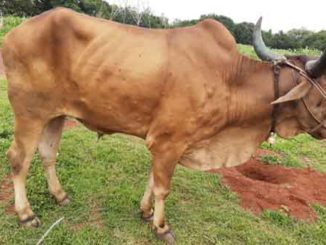Introduction
A total mixed ration (TMR) feeding allows a dairy cow to achieve optimum efficiency. It has been the most commonly accepted system since its introduction in the 1950s for feeding indoor, high-producing, dairy cows worldwide. This is achieved by providing a sufficient nutritional ration always, enabling cows to consume as closely as possible to their true energy needs while maintaining the physical or roughage characteristics that we call feed particle size essential for the proper function of the rumen. However, before selecting a TMR it is important to assess the benefits and drawbacks of any feeding method. Proper nutrition is essential to ensure that the cow is both healthy and optimal in the production of milk. The cow’s diet must be composed of a mixture of high-quality forages, a well-balanced blend of grains and protein sources plus minerals and vitamins. This will provide the cows with a nutritional balance, preventing any excesses or shortcomings that would allow the cow for milk production, growth, and also reproduction. Feeding a TMR containing all the feedstuffs and nutrients needed for the cow will assist the dairy cow to achieve optimum output as well as to improve the farm’s profitability.
What is a TMR?
A TMR is a method of feeding cows through a combination of all forages, grains, protein feeds, minerals, vitamins, and feed additives formulated for a specified concentration of nutrients into a single blend of feed. When all the ingredients are combined, cows are less capable of selecting the individual ingredients to consume and more likely to get a well-balanced, well-rounded ration with each bite. For a 24-hour duration, it can constitute a single source of feed and can be provided ad libitum for best performances. This cannot be done without using specific weighing equipment and adequate and proper mixing equipment (feed mixer wagon).
Preparation of TMR
The preparation of TMR for lactating cows, growing heifers and dry animal scan be achieved using various combinations of roughages and concentrates feed. In the formulation, crop residues and by-products that are locally available may be used in proportion as needed by the animals. The proportion of roughage in TMR depends on the fiber type and efficiency of the animals. With the help of a chopper, the crop residues are first made into small pieces and then ground to small particle size with the aid of a hammer mill type grinder, and then the roughage and concentrate are blended in a mixer to create a consistent blend.
Table 1. Ingredients (%) in TMR
| Roughage |
50-70 |
| Energy supplement |
3-30 |
| Protein supplement |
5-20 |
| Cereal by-products |
0-30 |
| Urea |
0-1 |
| Molasses |
5-10 |
| Mineral mixture |
1-2 |
| Salt |
0.5-1.0 |
| Vitamin supplement |
10g/100kg |
General guidelines to formulate a TMR for dairy cows:
- The main goal when formulating TMR is to optimize dry matter intake. The total intake of dry matter should be consistent with the production of milk and breeds. Only good quality forages should be fed to highly productive cows.
- The amount, particle size and fiber characteristics of roughage are the key factors in holding the productivity of the animals. The roughage could account for 40-60% of TMR in growing calves, while in lactating animals the inclusion of straw should be between 30-40% for high and medium yielding animals and 40-60% for low yields.
- The difference in the ration between groups should be kept to a minimum to prevent reduction of milk yield when the cows are transferred to different groups. The amounts of concentrate dry matter and protein would depend significantly on the level of milk production and the kind of forage used.
- The percentage of concentrate dry matter can be adjusted in a single group of TMR systems. For more energy, thinner cows should be given more supplementary feed while over-conditioned cows should be fed less. As a rule of thumb, for the respective milk production levels, it is important to follow good nutritional practices with regard to crude protein, energy, fat, minerals, vitamins, and non-fiber carbohydrates.
Table 2. TMR formulations for cattle (For 100 kg feed)
| Ingredient |
Type 1 |
Type 2 | Type 3 |
Type 4 |
| Maize/Sorghum/Bajra grains |
10 |
4 | 5 |
6 |
| Groundnut/Soybean meal |
15 |
15 | 10 |
6 |
| De-oiled Sunflower cake |
10 |
5 | 4 | 5 |
| Rice bran/DORB |
22 |
23 | 18 |
10 |
| Molasses |
10 |
10 | 10 |
10 |
| Maize/wheat/jowar straw/dry grasses |
30 |
40 | 50 |
60 |
| Mineral mixture |
2 |
2 | 2 |
2 |
|
Salt |
1 | 1 | 1 |
1 |
Type 1: For high producing dairy animals (more than 20 kg milk/day);
Type 2 and 3: For medium producers, growing heifers and pregnant animals;
Type 4: For dry animals
Advantages of feeding a TMR
The many benefits of TMR are weighed against their disadvantages for farmers to decide whether such a feeding system is for them to adopt. Those are:
- Increased intakes of dry matter (DMI).Peak DMI has been obtained 4 to 8 weeks before traditional systems.
- With every bite or mouthful, cows will eat a nutrient-balanced ration.
- A 4% increase in feed utilization can be expected when using a TMR compared to a conventional ration of forage and grain fed separately, twice daily.
- The ability of the cow to select individual ration ingredients will be reduced because all the forages, grains, proteins, minerals and vitamins are all well combined.
- Cows will eat a fixed amount of forages and concentrates needed for good production and health. It’s harder for cows to be picky while eating.
- A TMR provides more control and accuracy over the amount of feed given than the ingredients provided separately.
- A TMR lowers the risk of digestive upset, stabilizes rumen pH and optimizes rumen feed digestion.
- Increased milk production by approximately 5 to 8% as compared to conventional rations.
- TMR increases the milk fat. It is mainly because of improved fermentation of the rumen and balanced nutrients being consumed through TMR.
- A wider variety of less palatable feeds such as urea, limestone, fat scan be utilized in the ration as these are masked by the other ingredients by the elimination of selection.
- Byproduct feed stuffs like wet brewer’s grains, which can be inefficient to use in conventional feeding systems, also fit very readily into a TMR system.
- TMR mixers can reduce the work of feeding cows, reduce feed wastage and save labor costs.
Disadvantages of feeding a TMR
From a realistic viewpoint, there are many problems when a farm adapts to this feeding program, those are:
- The same ration applies to all cows in the group. Therefore, individual feeding cannot be achieved.
- For the ration, mixing or blending equipment are necessary. Feed mixers and weighing machines can be very expensive.
- Feed must be periodically pushed to ensure that animals do not sort the ration when there is continuous availability of feed.
- Some TMR mixers may not mix well with dry forages such as hay or straw. Additional equipment is needed to cut the hay or straw before adding to the mixer to solve this problem and this will incur additional expense.
- In a TMR program, feed analysis and ration balancing are becoming much more relevant. Farmers who do not routinely perform such activities won’t achieve the best results.
- Since one TMR mix is fed to a large number of cows, a miscalculation, weighing or mixing error can have a much greater impact on milk production than in other feeding systems where errors appear to occur more often for individual cows.
- Moreover, it may not be cost-effective for all herds, especially small herds or those which have been feeding pasture for a longer period of time.
Important points to consider for TMR feeding
- The one rule in effectively feeding a TMR above all is that the moisture content of the silages and the wet by-product ingredients being fed must be tracked regularly and the ration modified accordingly.
- A TMR is intended to provide a sufficient amount of dry matter in a balanced diet from forages. Intake may be depressed when the TMRs contain less than 50% dry matter. Particularly in TMRs designed for a high output group, care should be taken to remain above that limit.
- Regular laboratory analysis of TMR materials, in particular forage, is important in order to reduce the use of nutritional safety margins and to increase income-over feed costs.
- Before feeding count the number of cows in a group every day. This will enable the farmers to feed the right amount per cow.
- Two times feeding of TMR can be done during the cooler hours of the day in the summers. Once-time feeding can be done in winter.
- Fed bunks should not be left empty longer than 2-3 hours a day to optimize dry matter intake and production.
- Keep the TMR fresh. Don’t let the TMR sit around before feeding, especially during hot weather.
Conclusion
TMR can be a potential substitute to conventional feeding systems. It allows animals to feed nutritionally balanced diets more accurately because sorting and separation of ingredients is minimized. TMR helps in better feed consumption, avoids feed refusal of unpalatable feed stuffs, increases the scope for using cheap and bulky by-products available locally, helps in easy monitoring of feed intake by animals, enables to control the ratio of concentrate to roughage thereby reducing the feed cost, increases the resting time in animals, maintains normal acetic to propionic acid with less fluctuation in the release of ammonia in rumen, helps in utilizing non-protein nitrogen more efficiently. However, there are some limitations for adopting this system as it is not economically viable in small herds as it requires huge machinery and technical expertise. This can be best achieved by the interventions or policies of the government in the establishment of TMR feed plants by public-private-partnership (PPP) for the efficient supply of TMR to the needy small and medium farmers.







Please explain, how to calculate TMR quantity per Cow